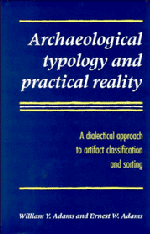 Archaeological Typology and Practical Reality
Archaeological Typology and Practical Reality Book contents
- Frontmatter
- Contents
- List of figures
- List of tables
- The archaeologist's preface
- The philosopher's preface
- PART I Introductory
- PART II The nature of types and typologies
- 3 Dimensions and elements of “typehood”
- 4 Perceptual and conceptual foundations
- 5 The dialectics of type formulation
- 6 The nature of types
- 7 The structure of typologies
- 8 A synthetic definition of typology and type
- PART III Typology in action: the Medieval Nubian Pottery Typology
- PART IV Pragmatics of archaeological typology
- PART V Classification, explanation, and theory
- Appendices
- References
- Index
8 - A synthetic definition of typology and type
Published online by Cambridge University Press: 23 November 2009
- Frontmatter
- Contents
- List of figures
- List of tables
- The archaeologist's preface
- The philosopher's preface
- PART I Introductory
- PART II The nature of types and typologies
- 3 Dimensions and elements of “typehood”
- 4 Perceptual and conceptual foundations
- 5 The dialectics of type formulation
- 6 The nature of types
- 7 The structure of typologies
- 8 A synthetic definition of typology and type
- PART III Typology in action: the Medieval Nubian Pottery Typology
- PART IV Pragmatics of archaeological typology
- PART V Classification, explanation, and theory
- Appendices
- References
- Index
Summary
The various concepts that were discussed in the three preceding chapters may now be synthesized into a single, synthetic definition of “typology” and “type.” This will necessarily be a cumbersome formulation, since a large number of individual concepts is involved. Following the example of Geertz (1966: 4) in his famous definition of religion, we will first state the definition, then break it down into its constituent elements, then analyze each element for its significance.
Definition
A typology is a conceptual system made by partitioning a specified field of entities into a comprehensive set of mutually exclusive types, according to a set of common criteria dictated by the purpose of the typologist. Within any typology, each type is a category created by the typologist, into which he can place discrete entities having specific identifying characteristics, to distinguish them from entities having other characteristics, in a way that is meaningful to the purpose of the typology.
The definition can now be analyzed in terms of the following components: (1) A typology is a conceptual system (2) made by partitioning (3) a specified field of entities (4) into a comprehensive set (5) of mutually exclusive types (6) according to a set of common criteria (7) dictated by the purpose (8) of the typologist.
- Type
- Chapter
- Information
- Archaeological Typology and Practical RealityA Dialectical Approach to Artifact Classification and Sorting, pp. 91 - 96Publisher: Cambridge University PressPrint publication year: 1991
